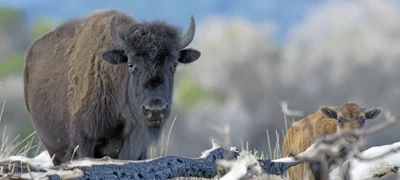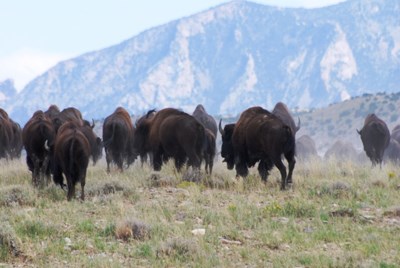Last updated: November 6, 2017
Article
Bison Bellows: Bureau of Land Management's Henry Mountains Herd

Photo courtesy of Bill Bates.
Comprised of roughly two million acres of isolated public land, Utah's Henry Mountains offer incredible recreation opportunities, mountains reaching over 11,000 feet in elevation, and a unique collection of sphinx-shaped rocks known as Little Egypt. And where the Colorado Plateau turns into snow-capped peaks, a free-ranging bison herd calls the place home.
In 1941, the Utah Division of Wildlife Resources and Carbon/Emery Wildlife Federation obtained 18 bison from Yellowstone National Park in cooperation with the National Park Service. This cooperation and collaboration between agencies constitute a key ingredient for successful bison management in the Henry Mountains. In joint partnership, the Bureau of Land Management (BLM) and Utah Division of Wildlife Resources manage the Henry Mountains bison herd. "We really couldn't do it without everyone involved," said Bill Bates, Wildlife Section Chief for the Utah Division of Wildlife Resources. "We have bison due to public support and the cooperative approach we take." Bison are legally classified as wildlife in Utah and the state of Utah issues hunting permits to manage the herd. The BLM manages the habitat, balancing needs for bison and livestock. Bates mentions that the Utah Division of Wildlife Resources also works closely with grazing permit holders, sportsman, and livestock owners. "They are all an integral part of bison management and we have lots of buy-in from these stakeholders," said Bates. Public support and involvement from multiple organizations allows for beneficial solutions for herd management as well as helps ensure quality habitat.

Photo courtesy of Bill Bates.
Together, the BLM and Utah Division of Wildlife Resources participate in annual helicopter surveys, habitat management, and summer ground classifications. Since bison and livestock utilize similar habitat in the Henry Mountains, habitat quality is an important focus for resource managers. The BLM and Utah Division of Wildlife Resources have aggressively worked to improve habitat, including reseeding a 42,000-acre burn area, habitat improvement projects, water developments, and adjusting grazing pressure to benefit both livestock and bison. Sportsmen for Fish and Wildlife, a wildlife conservation group, joined with the Division and BLM to fund a multi-year research project through Utah State University to look at bison movement patterns, habitat use, sightability during the helicopter surveys, and competition with cattle for forage. The results from this study are being used in a collaborative approach to manage the bison herd on the Henry Mountains.
Whether the focus is on habitat quality or bison management, collaboration between a diversity of stakeholders truly attributes to the success of the bison herd in the Henry Mountains. As Bates says, "a cooperative approach is key for bison management." The Henry Mountains bison herd is truly a national treasure, as one of the few free-ranging, disease free herds in the wild.
